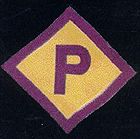
Zivilarbeiter
Encyclopedia

General Government
The General Government was an area of Second Republic of Poland under Nazi German rule during World War II; designated as a separate region of the Third Reich between 1939–1945...
(occupied Poland), used during WWII as forced laborers in Germany
Forced labor in Germany during World War II
The use of forced labour in Nazi Germany and throughout German-occupied Europe during World War II took place on an unprecedented scale. It was a vital part of the German economic exploitation of conquered territories. It also contributed to the mass extermination of populations in German-occupied...
. Poles were conscripted on the basis of the Polish decrees
Polish decrees
Polish decrees, Polish directives or decrees on Poles refer to the decrees of the Nazi Germany government announced on 8 March 1940 during World War II. They concerned the Polish laborers used during WWII as forced laborers in Germany, regulating their working and living conditions...
(Polenerlasse).

Polish decrees
Polish decrees, Polish directives or decrees on Poles refer to the decrees of the Nazi Germany government announced on 8 March 1940 during World War II. They concerned the Polish laborers used during WWII as forced laborers in Germany, regulating their working and living conditions...
). Compared to German workers of foreign workers from neutral or German allied countries, Polish Zivilarbeiters received lower wages and could not use public conveniences (such as public transport) or visit many public spaces and businesses (for example they could not attend a German church service, swimming pools or restaurant); they had to work longer hours than Germans; they received smaller food rations; they were subject to a curfew
Curfew
A curfew is an order specifying a time after which certain regulations apply. Examples:# An order by a government for certain persons to return home daily before a certain time...
; they often were denied holidays and had to work seven days a week; could not enter a marriage without permission; possess money or objects of value. Bicycles, cameras and even lighters were forbidden. They were required to wear a sign - the „Polish-P“ - attached to their clothing.
In 1939 there were about 300,000 prisoners from Poland working in Germany; Already in 1944 there were about 2,8 m Polish Zivilarbeiters in Germany (approximately 10% of Generalgouvernement workforce) and a similar number of workers in this category from other countries.
Poles from territories taken over after the German invasion of the Soviet Union and not included in the General Government
General Government
The General Government was an area of Second Republic of Poland under Nazi German rule during World War II; designated as a separate region of the Third Reich between 1939–1945...
were treated as OST-Arbeiter
OST-Arbeiter
OST-Arbeiter was a designation for slave workers gathered from Eastern Europe to do forced labor in Germany during World War II. The Ostarbeiters were mostly from the territory of Reichskommissariat Ukraine . Ukrainians made up the largest portion although many Belarusians, Russians, Poles and...
s.

